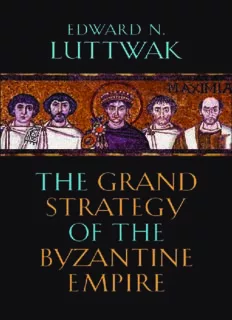
The Grand Strategy of the Byzantine Empire PDF
Preview The Grand Strategy of the Byzantine Empire
TheGrandStrategyoftheByzantineEmpire The Grand Strategy of the Byzantine Empire EDWARD N. LUTTWAK THE BELKNAP PRESS OF HARVARD UNIVERSITY PRESS Cambridge,Massachusetts,andLondon,England 2009 Copyright©2009bythePresidentandFellowsofHarvardCollege Allrightsreserved PrintedintheUnitedStatesofAmerica LibraryofCongressCataloging-in-PublicationData Luttwak,Edward. ThegrandstrategyoftheByzantineEmpire / EdwardN.Luttwak. p. cm. Includesbibliographicalreferencesandindex. ISBN978-0-674-03519-5(cloth : alk.paper) 1.ByzantineEmpire—Militarypolicy. 2.Strategy—History—To1500. 3.Militaryartandscience—ByzantineEmpire— History. 4.Imperialism—History—To1500. 5.ByzantineEmpire—History,Military. 6.ByzantineEmpire—Foreignrelations. I.Title. U163.L86 2009 355′.033549500902—dc22 2009011799 Contents ListofMaps vii Preface ix I TheInventionofByzantineStrategy 1 1 AttilaandtheCrisisofEmpire 17 2 TheEmergenceoftheNewStrategy 49 II ByzantineDiplomacy:TheMythandtheMethods 95 3 Envoys 97 4 ReligionandStatecraft 113 5 TheUsesofImperialPrestige 124 6 DynasticMarriages 137 7 TheGeographyofPower 145 8 BulgharsandBulgarians 171 9 TheMuslimArabsandTurks 197 vi (cid:129) Contents III TheByzantineArtofWar 235 10 TheClassicalInheritance 239 11 TheStrategikonofMaurikios 266 12 AftertheStrategikon 304 13 LeoVIandNavalWarfare 322 14 TheTenth-CenturyMilitaryRenaissance 338 15 StrategicManeuver:HerakleiosDefeatsPersia 393 Conclusion:GrandStrategyandtheByzantine “OperationalCode” 409 Appendix:WasStrategyFeasibleinByzantineTimes? 421 EmperorsfromConstantineItoConstantineXI 423 Glossary 427 Notes 433 WorksCited 473 IndexofNames 491 GeneralIndex 495 Maps 1. Thedivisionoftheempireafter thedeathofTheodosiusIin395 2 2. TheGreatEurasianSteppe 8 3. ThedefensesofConstantinople 68 4. Theempireattheaccessionand deathofJustinian,527–565 82 5. Theempirein1025atthedeathofBasilII 194 6. TheMuslimoffensives,662–740 200 7. Theempirein668,aftertheSlav,Lombard, andMusliminvasions 213 8. Theempirein780,aftertheMuslimconquests andtheBulgharsettlement 216 9. Theempirein1081attheaccessionof AlexiosIKomnenos 228 10. Theempirein1143atthedeathofJohnIIKomnenos 230 11. Theempireatthedeathof MichaelVIIIPalaiologosin1282 233 12. TheSasanianempire,ca.226–ca.651 394 13. Theempirein565,1025,and1360 411 Preface Oncelargelyneglected,asiftheentireRomanempirehadreallyended in476,theeasternhalfthatwecallByzantinebymodernhabitnowat- tractssomuchattentionthatitiseventhesubjectofpopularhistories. While many are interested in the culture of Byzantium, it is the epic struggle to defend the empire for century after century against an un- endingsequenceofenemiesthatseemstoresonateespeciallyinourown times. This book is devoted to one dimension of Byzantine history: the application of method and ingenuity in the use of both persuasion and force—that is to say, strategy in all its aspects, from higher statecraft downtomilitarytactics. When I first started to study Byzantine strategy in earnest, I had just completedabookonthestrategyoftheRomanempireuptothethird century that continues to attract both inordinate praise and strenuous criticism.Myoriginalintentionwassimplytowriteasecondvolumeto coverthesubsequentcenturies.Whatensuedinsteadwasthediscovery of an altogether richer body of strategy than the earlier Romans had ever possessed, which called for a vastly greater effort of research and composition. In the end, this lasted for more than two decades, albeit withmanyinterruptions—someduetomynotentirelyunrelatedwork in applying military strategy in the field. There was one compensation forthisprolongeddelay:severalessentialByzantinetextsonceavailable onlyasscarcelyaccessiblemanuscripts,orinantiquatededitionsreplete witherrors,havenowbeenpublishedinreliableform.Also,aconsider-
Description: